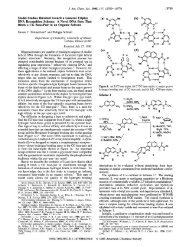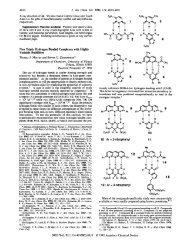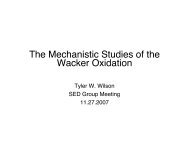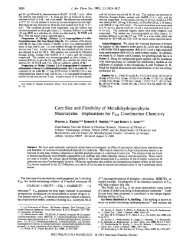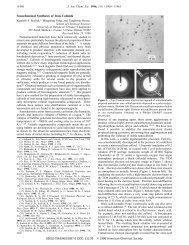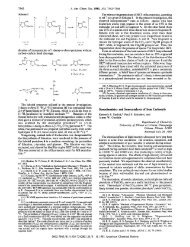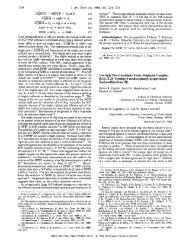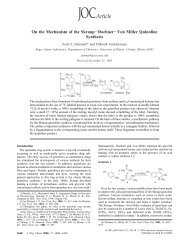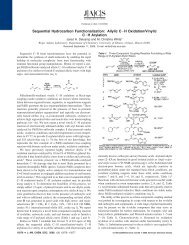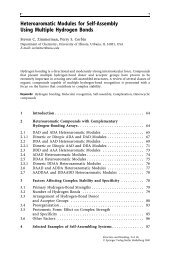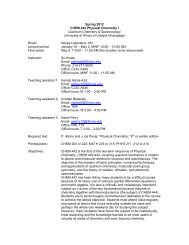Download PDF - Whitesides Research Group - Harvard University
Download PDF - Whitesides Research Group - Harvard University
Download PDF - Whitesides Research Group - Harvard University
Create successful ePaper yourself
Turn your PDF publications into a flip-book with our unique Google optimized e-Paper software.
Fabrication inside Microchannels Using Fluid Flow<br />
Kenis et al.<br />
Table 1. Techniques Used for Microfabrication inside<br />
Microchannels<br />
FIGURE 1. Optical micrograph of two-phase laminar flow: two<br />
aqueous phases, each colored with a different dye (black ink and<br />
Congo red), brought together with a “Y” junction in an elastomeric<br />
microfluidic system.<br />
tion that use a single stream of liquid. In the fourth,<br />
wesketch applications of microfabrication (and closely<br />
related methods used for micropatterning of bacterial and<br />
mammalian cells) based on multiple streams of liquid in<br />
laminar flow.<br />
I. Overview of Microfabrication in<br />
Microchannels<br />
Table 1 lists technologies (including our own) that have<br />
been used to carry out microfabrication in capillaries.<br />
Conventional photolithography is the basis of the methods<br />
most commonly used to fabricate microchannels containing<br />
functional microstructures. 2 In this type of fabrication,<br />
the capillary and its internal features are generated by a<br />
series of planar pattern-transfer steps. Until recently, there<br />
were few alternatives to photolithography (and the processes<br />
intimately associated with it: evaporation, CVD,<br />
RIE, lift-off, and others). Miyagi et al. have, for example,<br />
patterned the inner walls of hollow waveguides by chemical<br />
vapor deposition of dielectric films consisting of Cu 2 O. 3<br />
Renn and Pastel have shown that laser-induced forces<br />
(light tweezers) can be used to manipulate and position<br />
atoms, clusters, and micrometer-sized particles (e.g., NaCl<br />
and KI crystals) inside hollow optical fibers. 4<br />
II. Laminar and Turbulent Flow of Liquids: The<br />
Reynolds Number<br />
The Reynolds number, Re ) vlF/µ, characterizes the<br />
tendency of a fluid to develop turbulence, or to flow<br />
without turbulence (that is, laminarly). 5 Here, F is the<br />
density in kilograms per cubic meter, µ is the viscosity in<br />
kilograms per meter per second, l is the diameter of the<br />
capillary in meters, and v is the flow rate in meters per<br />
second. The value of Re at which flow changes from<br />
turbulent to laminar depends on the geometry of the<br />
channel. For a straight pipe, this transition occurs at Re<br />
≈ 2100. Flow past an object or flow in a channel in which<br />
the geometry changes, however, develops eddies at lower<br />
Reynolds numbers (Re ≈ 40-300). Liquid flows in capillaries<br />
(that is, tubes having small values of l; l ≈ 50-100<br />
µm) often have low values of Re and are therefore laminar,<br />
even for liquid flow velocities as high as 0.5 m s -1 . Most<br />
usefully, two or more streams that are brought together<br />
in a narrow channel flow laminarly, in parallel, without<br />
turbulent mixing (Figure 1). The only mechanism of<br />
mixing of their components is diffusion across the interface<br />
between the streams.<br />
Laminar flow permits control of the spatial delivery of<br />
reagents within a capillary. The application of different<br />
chemistries from different streams of a multiphase, laminar<br />
flow system allows reactions to take place exclusively<br />
at certain regions of the capillary: either between a stream<br />
and the interior surface of the capillary, or at the interface<br />
between adjacent streams. Levin et al. pioneered the use<br />
of laminar flow in microfluidic devices to fractionate<br />
samples by taking advantage of the fast diffusion of small<br />
molecules or ions from one stream into an adjacent<br />
stream, relative to the slow diffusion of proteins, colloids,<br />
etc. 6 Weigl and Yager implemented these principles<br />
elegantly in a micromachined device for the analysis of<br />
heterogeneous biological samples such as blood by taking<br />
advantage of the fast diffusion of analyte molecules from<br />
the sample stream into an adjacent stream that contained,<br />
for example, a fluorescent indicator. 7<br />
In small capillaries, turbulent flow of aqueous solutions<br />
(or eddy-like flow in the region of transition from laminar<br />
to turbulent) occurs only at high velocities of flow.<br />
Turbulence facilitates mass transport. In laminar flow, the<br />
only mechanism for mixing is diffusion. This difference<br />
in mechanisms and rates of mass transport can be used<br />
to increase the rate of delivery of reagents to specific<br />
regions inside a capillary where flow is turbulent, and thus<br />
to increase the rate of chemical reaction in the turbulent<br />
regions, relative to regions where flow is laminar.<br />
III. Microfabrication Using Single Streams of<br />
Liquid in Microchannels<br />
We distinguish different methods of fabrication inside<br />
microchannels using a single stream of liquid: one that<br />
results in a uniform modification of the inner surface of<br />
the capillary, and several others that allow for fabrication<br />
with spatial resolution.<br />
Uniform In-Channel Coatings. A uniform coatings<br />
either covalently attached or physically adsorbedson the<br />
inner surface of capillaries can easily be achieved from a<br />
single liquid streamslaminar or turbulentsthat contains<br />
842 ACCOUNTS OF CHEMICAL RESEARCH / VOL. 33, NO. 12, 2000



